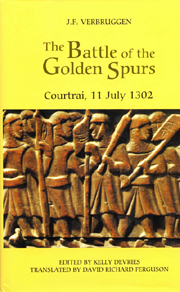 The Battle of the Golden Spurs (Courtrai, 11 July 1302)
The Battle of the Golden Spurs (Courtrai, 11 July 1302) Book contents
- Frontmatter
- Contents
- List of Illustrations
- General Editor's Preface
- Editor's Introduction to the 2002 edition
- Foreword to the 1952 edition
- Acknowledgements (to the 1952 edition)
- Preface: ‘An almost impossible event …’
- Introduction
- Part One Historiography and the Study of the Sources
- Part Two Historical Overview of the 1302 Campaign
- 3 The Terrain at Courtrai
- 4 The Two Armies
- 5 From the Bruges Matins to the Battle of the Spurs for freedom, equality and fraternity
- 6 11 July 1302
- General Conclusion
- Bibliography
- Index
4 - The Two Armies
from Part Two - Historical Overview of the 1302 Campaign
Published online by Cambridge University Press: 12 September 2012
- Frontmatter
- Contents
- List of Illustrations
- General Editor's Preface
- Editor's Introduction to the 2002 edition
- Foreword to the 1952 edition
- Acknowledgements (to the 1952 edition)
- Preface: ‘An almost impossible event …’
- Introduction
- Part One Historiography and the Study of the Sources
- Part Two Historical Overview of the 1302 Campaign
- 3 The Terrain at Courtrai
- 4 The Two Armies
- 5 From the Bruges Matins to the Battle of the Spurs for freedom, equality and fraternity
- 6 11 July 1302
- General Conclusion
- Bibliography
- Index
Summary
The Numerical Strength of the Two Armies
The Flemish forces
On 11 July 1302, three major divisions were grouped together under the Flemish flag. The right wing was formed of militias from Bruges, the centre of men of the Bruges Franc. The left wing was formed of men of East Flanders, joined by the men of Ghent who had come together with Jan Borluut. Jan van Renesse took his post behind their ranks with the reserve corps. The men of Ypres were positioned before the castle of Courtrai.
Soldiers from the Waas country were fully occupied with the siege of the Rupelmonde castle and with surrounding Ghent. This was also the case for the men of the Four Ambachten, where perhaps several of those fighting belonged to the entourage of certain noblemen present. In Ghent the Flemish supporters of the King of France were still in power, so that no militia was sent from the town.
The rebel army consisted predominantly of artisans and peasants supported by foreign mercenaries and Flemish nobles. What was the numerical strength of each of these contingents?
The town militias
Two special contingents from the Flemish towns are known to have taken part since they were only represented by a few of their soldiers: the men of Ypres and Ghent. In Ypres, those favourable to the French cause were still in power, although the guildsmen rallied behind the insurgents. The town council, however, limited the number of the town contingent to five hundred men and a number of crossbowmen.
- Type
- Chapter
- Information
- The Battle of the Golden Spurs (Courtrai, 11 July 1302)A Contribution to the History of Flanders' War of Liberation, 1297–1305, pp. 152 - 210Publisher: Boydell & BrewerPrint publication year: 2001
